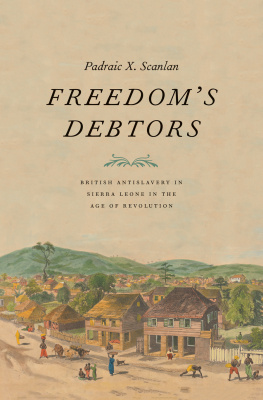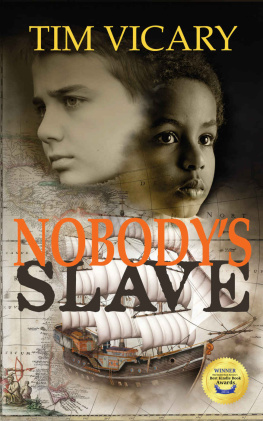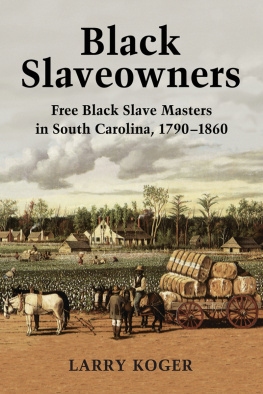The Voyage of the Slave Ship Hare
Published with the assistance of the Anniversary Fund of the University of North Carolina Press
2016 The University of North Carolina Press
All rights reserved
Set in Charter and IM Fell
by codeMantra
Manufactured in the United States of America
The paper in this book meets the guidelines for permanence and durability of the Committee on Production Guidelines for Book Longevity of the Council on Library Resources.
The University of North Carolina Press has been a member of the Green Press Initiative since 2003.
Cover illustration: Bance Island in 1748 (The National Archives of the U.K., ref. CO700/SIERRALEONE1A [1]), with a background texture courtesy of Bittbox
Library of Congress Cataloging-in-Publication Data
Names: Kelley, Sean M., 1966 author.
Title: The voyage of the slave ship Hare : a journey into captivity from Sierra Leone to South Carolina / Sean M. Kelley.
Description: Chapel Hill : The University of North Carolina Press, [2016] | Includes bibliographical references and index.
Identifiers: LCCN 2015039986| ISBN 9781469627687 (cloth : alk. paper) | ISBN 9781469627694 (ebook)
Subjects: LCSH: Hare (Ship) | Slave shipsUnited StatesHistory18th century. | SlavesSouth Carolina18th century. | Slave tradeSouth CarolinaHistory18th century. | Slave tradeSierra LeoneHistory18th century.
Classification: LCC E445.S7 K45 2016 | DDC 306.3/620975709033dc23 LC record available at http://lccn.loc.gov/2015039986
To Kathleen
Contents
Figures and Maps
Figures
1.1. Map of Newport, 1777
1.2. View of Newport, ca. 1730
1.3. Sloop
2.1. Slave-ship horoscope
3.1. Bance Island in 1748
4.1. A Fula caravan
5.1. Bridgetown, ca. 1695
6.1. Charles Town, 1780
6.2. View of Charles Town, 1776
6.3. Gabriel Manigault, 1757
6.4. Henry Laurens, 1782
Maps
3.1. Sierra Leone and vicinity
3.2. The Upper Guinea coast from Cape Verga to Cape Mount
6.1. Geographic distribution of the Hare captives after initial sale
Acknowledgments
When I began research on this book, I scarcely understood just how much I would depend on others for advice, criticism, and support. To start, I owe a tremendous debt of inspiration to Robert Harms, whose own study served as a model for this one, and who reassured me over lunch that there was room in the world for more than one such book. This study also benefitted immeasurably from the wide-ranging expertise of many other scholars. Paul Lovejoy in particular supported the project from the start and has offered invaluable guidance. Bruce Mouser read an entire draft and shared his vast knowledge of the Rio Pongo and Northern Rivers with me. Jane Landers and Bob Olwell each took time out from their busy schedules to read complete drafts and offer their perspectives. Jim Oakes and his students at the CUNY Graduate Center read the entire manuscript and provided extensive and valuable critique, as did an anonymous reader for UNC Press.
I am also very grateful to Doug Bradburn, Diane Sommerville, Dave Hacker, and all of the members of the Upstate Early American History Workshop for reading an 87-page section without complaint. Thank you also to Bill Ashbaugh, Ed Baptist, Jos Curto, Lisle Dalton, Dora Dumont, Jeff Fortin, Matthew Hendley, Joanne Melish, Robin Mitchell, Kenneth Morgan, Philip Morgan, Anthony Parent, David Richardson, Heather Schwartz, Suzanne Schwarz, David Trotman, and Larry Yarak, each of whom commented on smaller sections as chapters, conference papers, or article drafts. Roark Atkinson, David Eltis, Michael Jarvis, Kristin Jones, Walter Kamphoefner, Peter Kolchin, Jonathan Roberts, Jim Sidbury, and Tom Thurston each provided sources, advice, or support. I owe a special thanks to Joseph Opala and Phil Misevich, who advised me on my visit to Sierra Leone, and to Alpha Kanu and Ibrahima Bangura, who made my visit a successful and memorable one. Thanks are also due to David Klempner for hosting me in London on several occasions and to Lance and Melissa Schacterle for opening their home to me during my time in Worcester.
This project has also benefitted from the financial support of the National Endowment for the Humanities and the American Antiquarian Society (AAS). Special thanks are due to Paul Erickson for making my fellowship year at AAS an especially productive and rewarding experience. I can think of no better home for an Early Americanist than AAS, where the collections are surpassed only by the expertise and helpfulness of the entire staff. Thanks also to Hartwick College for awarding me Trustee Research Grants from 2008 to 2011, the funds from which allowed me to visit archives on three continents. I was also fortunate to work with several outstanding archivists and librarians, including Jane Aldrich of the South Carolina Historical Society, Graham Duncan of the South Caroliniana Library, Bert Lippincott of the Newport Historical Society, and Elizabeth Pope and Jackie Penny of AAS. Dawn Baker, Peter Riesler, and Sue Stevens of the Interlibrary Loan Department at Hartwicks Stevens-German Library worked miracles on a regular basis. Sir Archibald Grant very kindly allowed me access to the Grant of Monymusk Papers in the National Archives of Scotland. Finally, and most importantly, thank you to Vicki and Kathleen for supporting the project without reservation and for tolerating my frequent absences.
The Voyage of the Slave Ship Hare
Introduction
They had names, the seventy-two people Caleb Godfrey purchased on the Upper Guinea coast in late 1754, but we do not know what they were. They were mothers and fathers, sons and daughters, brothers, sisters, and cousins. They surely possessed as wide a range of characteristics as can be found in any collection of seventy-two people, but we will never know what those were. The very existence of the seventy-two men, women, and children Godfrey packed onto the sloop Hare is revealed to us solely as a consequence of their enslavement. They enter the historical record as a mere tally of goods to be purchased and sold: twenty-eight men, twenty-five women, twelve girls, and seven boys.
It is no accident that the Hare captives names were never recorded. Slaves are people whose right to kinship has been extinguished. Names speak to kinship, belonging in a community, and personhood before the law. Godfreys elision was an intrinsic part of the process through which fathers, mothers, and children were transformed into commodities, the new property tie to the slave owner displacing the former ties of family and community. None of this means that the Hare captives or any other slaves actually ceased to be people or forgot who they were simply because someone did not consider it important to record their names, and none of it means that they failed to establish new family and community bonds. Still, we could say so much more about them if we knew their names.
This book reconstructs the voyage of a single Rhode Island sloop that carried captives from Sierra Leone to South Carolina in 175455. It seeks to answer a seemingly straightforward question: who were the Hare captives? The hope is that grappling with that problemeven if definitive answers should prove elusivewill yield new insight into the old question of the African experience in the New World, an issue that lies at the center of American history and identity. Most Americans are accustomed to thinking of their country as a historical extension of Europe. Few realize that by 1775,
The Hare captives experience offers a chance to revisit the long-standing historical question of African identities and cultures in the New World. With the inauguration of the modern debate in the 1990s, most historians, anthropologists, and linguists have championed one of two positions. On one side have stood proponents of what might be termed the Creolization thesis, the classic statement of which came from anthropologists Sidney Mintz and Richard Price in 1976 (and in a revised edition in 1992). Based largely on fieldwork done in the mid-twentieth century, Mintz and Price argued that it had not been possible for Africans to reconstitute specific cultures and identities in the Americas. The slave trade had recombined Africans of diverse linguistic and ethnic backgrounds to the extent that they constituted crowds more than coherent groups. New World plantations were therefore populated by an aggregate of randomly selected Africans with little in common. In that regard, Mintz and Prices vision of cultural disruption and discontinuity bore a passing resemblance to the older arguments of E. Franklin Frazier, even though in their vision of African American cultures as creative, dynamic, and sharing African-derived grammatical principles, they saw themselves as working in the tradition established by Melville J. Herskovits. Unable to form speech communities, they argued, Africans abandoned their languages and devised creoles. Lacking priesthoods and temples, they improvised new approaches to the sacred. As Mintz and Price stressed, the history of African American culture was one of dynamism and creativity. And given the conditions of the slave trade and the New World plantations, that dynamism and creativity played out primarily in the Americas. The result was a variety of hybridized, regional African American cultures, with an emphasis on the American.
Next page




